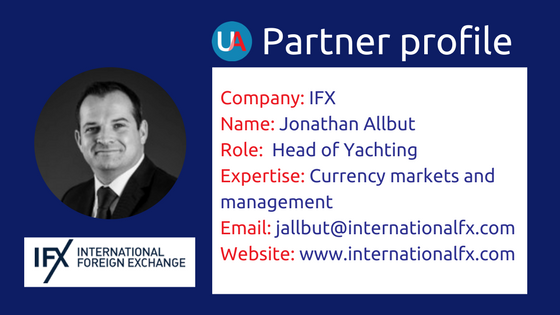For someone new to exchange rates, what are they exactly and why do they matter?
Think of exchange rates like the stock price of a country.
A stock price is determined by many contributing factors such as; profit and loss, staffing levels, past performance, expected growth, and company reputation. This is the same for the exchange rate of a country. Many pieces of economic data feed into just how much that currency is worth. The better the data for the country the stronger its currency becomes, making 1 unit of that currency purchase more units of another currency. This is what we refer to as a ‘strong’ currency.
Exchange rates give a snapshot of the country’s performance. They also affect how much money you will receive from a conversion of overseas wages. This is the most important factor for most yachties who can often be paid in one salary and have expenses in another.
What are some of the current market challenges?
Challenges in the market have recently come from unexpected political results. Although the market is unpredictable in nature, educated guesses can be made as to what general impact on the market each data release will have. Brexit was an unexpected result, to say the least. Most predicted the opposite, so when the ‘out’ camp won, the markets panicked. This meant the GBP was sold off in huge volumes.
One example to help explain why this happened in real world terms is, as people saw the GBP weaken, any planned overseas purchases became much more expensive as the GBP depreciated. This caused a rush from everyone in this position to convert the GBP into the foreign currency they sought before the GBP was worth even less.
Then came Trump. The markets had originally backed Hillary as the most likely victor. The expectation was she would win and the USD would strengthen. Conversely, the market thought that a Trump win would weaken the USD.
This was wrong on both counts! Trump’s win has seen the USD gain steadily over the last few months reaching multi-year highs against many currencies. Accurately predicting political outcomes and the resulting market reaction has been particularly challenging in 2016.
What are some of the common misconceptions about exchange rates?
The most common misconception is the rate seen through various channels is the rate that an individual will achieve. This simply is not the case. The rates used on television, in the newspapers, online and on various currency charts are the interbank or wholesale rates. These are rates reserved for banks sending funds in huge amounts between their own accounts. The rate an individual received will always be a customer rate and not the interbank so will be less than that seen initially. The second main misconception is that the transfer of funds internationally is incredibly costly. It is if a bank is used as additional sending, receiving and processing fees may be taken by the banks, along with a poor exchange rate. Whereas a deliverable FX provider makes the process much easier, cheaper and may be able to even automate the transfers for clients
What are the currencies to watch closely in 2017?
As I mentioned earlier, recent uncertainties have arisen from political results. With right wing politics gaining traction, Brexit, and Trump as President, eyes are now focused on Europe and the upcoming elections.
As a general rule of thumb investors do not like uncertainty. Mid- March has the Dutch general election. At the end of March, the self-imposed Brexit deadline will be reached. Early May brings with it the French presidential election and in October we end the year with German elections. Throughout the year we expect increased volatility for GBP. We should start to know what a post-Brexit Britain will look like and what trade agreements will be put in place. The EUR will change, as the political landscape for the future starts to emerge. Finally, USD will be impacted as the Trump presidency takes hold and the effect of new economic policy becomes clear.
What resources do you recommend using to monitor exchange rates?
It depends more on the requirements you have as an individual user.
Generally, rate alerts are the best. They will inform you when a particular rate is close to being achieved. These trigger off interbank or wholesale rates and are purely for your information purposes. They are beneficial as you do not have to monitor the markets as closely. You will simply set a target rate and will be informed when the rate climbs through these levels or falls below them. You can enter a limit order or stop loss that is the same as a rate alert but this is when you set a clear instruction.
For example, you can request that “When GBP/EUR is 1.18 please convert 20000 GBP”. This is hugely beneficial if you don’t have continual alert access. The stop losses work the same as a limit order but protect against downside movement. As opposed to maximising profit from the market volatility it limits loss. Both are very useful functions.
There are a number of free IFX currency tools available on the website that you can access HERE.
What is the worst fluctuation you’ve seen whilst working with IFX?
Fluctuations have been abundant over the last few years. Markets have reacted to huge changes and surprising data points. The one I remember from a few years ago is when I arrived in work to the news that Russia has increased its interest rates overnight from 10.5% to 17% its biggest rate hike since 1998. Causing the RUB to lose 2.5%. Hopefully, we won’t be seeing anything like this in 2017!
Any other exchange rate advice for yachties?
I would simply advise to looking at the market and see what has occurred previously. Using that information ask yourself what is your target rate, and what is the lowest rate you would be happy with. Contact your provider and setup a ‘Limit order’ to achieve the upper levels, and set a ‘Stop loss’ to prevent the currency falling past certain points.
Set this up as an “O.C.O” so if the upper level is reached it cancels the lower and vice versa to prevent both occurring and you being billed twice. You can set these limits to suit your requirements and it means even in areas of poor reception you will not miss out on a rate.





